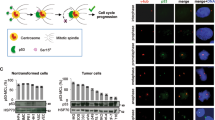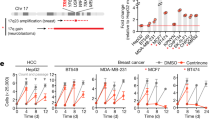Abstract
Chromosome loss or gain is associated with a large number of solid cancers, providing genomic plasticity and thus adaptability to cancer cells1,2. Numerical centrosome abnormalities arising from centrosome over-duplication or failed cytokinesis are a recognized cause of aneuploidy3,4. In higher eukaryotic cells, the centrosome duplicates only once per cell cycle to ensure the formation of a bipolar mitotic spindle that orchestrates the balanced distribution of the sister chromatids to the respective daughter cells5. Here we delineate the events that allow abnormal centrosome duplication, resulting in mitotic errors and incorrect chromosome segregation in cells with sustained cyclin-dependent kinase (CDK) activity. We have identified NPM1 as a substrate for CDK6 activated by the Kaposi's sarcoma herpesvirus (KSHV) D-type cyclin and shown that p53-driven apoptosis occurs downstream of NPM1 phosphorylation as a checkpoint mechanism that prevents accumulation of cells with supernumerary centrosomes. Our findings provide evidence that abnormal chromosome segregation in KSHV-infected cells is a direct consequence of NPM1 phosphorylation and predict that genomic instability is an inevitable consequence of latent KSHV infection.
This is a preview of subscription content, access via your institution
Access options
Subscribe to this journal
Receive 12 print issues and online access
$209.00 per year
only $17.42 per issue
Buy this article
- Purchase on Springer Link
- Instant access to full article PDF
Prices may be subject to local taxes which are calculated during checkout





Similar content being viewed by others
References
Weaver, B. A. & Cleveland, D. W. Does aneuploidy cause cancer? Curr. Opin. Cell Biol. 18, 658–667 (2006).
Kops, G. J., Weaver, B. A. & Cleveland, D. W. On the road to cancer: aneuploidy and the mitotic checkpoint. Nature Rev. Cancer 5, 773–785 (2005).
Fukasawa, K. Centrosome amplification, chromosome instability and cancer development. Cancer Lett. 230, 6–19 (2005).
Nigg, E. A. Origins and consequences of centrosome aberrations in human cancers. Int. J. Cancer 119, 2717–2723 (2006).
Hinchcliffe, E. H. & Sluder, G. “It takes two to tango”: understanding how centrosome duplication is regulated throughout the cell cycle. Genes Dev. 15, 1167–1181 (2001).
Fukasawa, K. Oncogenes and tumour suppressors take on centrosomes. Nature Rev. Cancer 7, 911–924 (2007).
Godden-Kent, D. et al. The cyclin encoded by Kaposi's sarcoma-associated herpesvirus stimulates cdk6 to phosphorylate the retinoblastoma protein and histone H1. J. Virol. 71, 4193–4198 (1997).
Mann, D. J., Child, E. S., Swanton, C., Laman, H. & Jones, N. Modulation of p27(Kip1) levels by the cyclin encoded by Kaposi's sarcoma-associated herpesvirus. EMBO J. 18, 654–663 (1999).
Platt, G. M., Cannell, E., Cuomo, M. E., Singh, S. & Mittnacht, S. Detection of the human herpesvirus 8-encoded cyclin protein in primary effusion lymphoma-derived cell lines. Virology 272, 257–266 (2000).
Verschuren, E. W., Klefstrom, J., Evan, G. I. & Jones, N. The oncogenic potential of Kaposi's sarcoma-associated herpesvirus cyclin is exposed by p53 loss in vitro and in vivo. Cancer Cell 2, 229–241 (2002).
Meraldi, P., Lukas, J., Fry, A. M., Bartek, J. & Nigg, E. A. Centrosome duplication in mammalian somatic cells requires E2F and Cdk2·cyclin A. Nature Cell Biol. 1, 88–93 (1999).
Cohen, P. & Knebel, A. KESTREL: a powerful method for identifying the physiological substrates of protein kinases. Biochem. J. 393, 1–6 (2006).
Knebel, A., Morrice, N. & Cohen, P. A novel method to identify protein kinase substrates: eEF2 kinase is phosphorylated and inhibited by SAPK4/p38δ. EMBO J. 20, 4360–4369 (2001).
Cuomo, M. E. et al. Regulation of microfilament organization by Kaposi sarcoma-associated herpes virus-cyclin.CDK6 phosphorylation of caldesmon. J. Biol. Chem. 280, 35844–35858 (2005).
Okuda, M. et al. Nucleophosmin/B23 is a target of CDK2/cyclin E in centrosome duplication. Cell 103, 127–140 (2000).
Tokuyama, Y., Horn, H. F., Kawamura, K., Tarapore, P. & Fukasawa, K. Specific phosphorylation of nucleophosmin on Thr(199) by cyclin-dependent kinase 2-cyclin E and its role in centrosome duplication. J. Biol. Chem. 276, 21529–21537 (2001).
Vieira, J., O'Hearn, P., Kimball, L., Chandran, B. & Corey, L. Activation of Kaposi's sarcoma-associated herpesvirus (human herpesvirus 8) lytic replication by human cytomegalovirus. J. Virol. 75, 1378–86 (2001).
Mussman, J. G. et al. Synergistic induction of centrosome hyperamplification by loss of p53 and cyclin E overexpression. Oncogene 19, 1635–1646 (2000).
Jr, J., Kong, W., Hottiger, M. O. & Nabel, G. J. p53 inhibition by the LANA protein of KSHV protects against cell death. Nature 402, 889–894 (1999).
Swanton, C. et al. Herpes viral cyclin/Cdk6 complexes evade inhibition by CDK inhibitor proteins. Nature 390, 184–187 (1997).
Thome, M. et al. Viral FLICE-inhibitory proteins (FLIPs) prevent apoptosis induced by death receptors. Nature 386, 517–521 (1997).
Cheng, E. H. et al. A Bcl-2 homolog encoded by Kaposi sarcoma-associated virus, human herpesvirus 8, inhibits apoptosis but does not heterodimerize with Bax or Bak. Proc. Natl Acad. Sci. USA 94, 690–694 (1997).
Ojala, P. M. et al. Kaposi's sarcoma-associated herpesvirus-encoded v-cyclin triggers apoptosis in cells with high levels of cyclin-dependent kinase 6. Cancer Res. 59, 4984–4989 (1999).
Gottifredi, V., Shieh, S., Taya, Y. & Prives, C. p53 accumulates but is functionally impaired when DNA synthesis is blocked. Proc. Natl Acad. Sci. USA 98, 1036–1041 (2001).
Tarapore, P., Horn, H. F., Tokuyama, Y. & Fukasawa, K. Direct regulation of the centrosome duplication cycle by the p53-p21Waf1/Cip1 pathway. Oncogene 20, 3173–3184 (2001).
Shinmura, K., Bennett, R. A., Tarapore, P. & Fukasawa, K. Direct evidence for the role of centrosomally localized p53 in the regulation of centrosome duplication. Oncogene 26, 2939–2944 (2007).
Grisendi, S., Mecucci, C., Falini, B. & Pandolfi, P. P. Nucleophosmin and cancer. Nature Rev. Cancer 6, 493–505 (2006).
Kurki, S. et al. Nucleolar protein NPM interacts with HDM2 and protects tumor suppressor protein p53 from HDM2-mediated degradation. Cancer Cell 5, 465–475 (2004).
Acknowledgements
This work was funded by a grant from Cancer Research UK. We thank Jeffrey Vieira for permission to use rKSHV and Dimitris Lagos and David J. Blackbourn for the generous gift of rKSHV BCBL-1 cells. We are grateful to Jonathan Pines and Kenji Fukasawa for providing essential reagents.
Author information
Authors and Affiliations
Contributions
M.E.C. designed and performed the experiments; A.K. and P.C provided crucial support and materials for the KESTREL screen; N.M. was responsible for the mass spectrometry data; H.P. assisted with the confocal and time-lapse microscopy; S.M. co-ordinated the research; M.E.C. and S.M. wrote the manuscript.
Corresponding author
Ethics declarations
Competing interests
The authors declare no competing financial interests.
Supplementary information
Supplementary Information
Supplementary Figures S1, S2, S3, S4, S5, S6, S7, S8 and Supplementary Methods (PDF 1474 kb)
Supplementary Information
Supplementary Movie 1 (AVI 2931 kb)
Supplementary Information
Supplementary Movie 2 (AVI 2924 kb)
Supplementary Information
Supplementary Movie 3 (AVI 3909 kb)
Supplementary Information
Supplementary Movie 4 (AVI 2924 kb)
Supplementary Information
Supplementary Movie 5 (AVI 2885 kb)
Supplementary Information
Supplementary Movie 6 (AVI 3964 kb)
Rights and permissions
About this article
Cite this article
Cuomo, M., Knebel, A., Morrice, N. et al. p53-Driven apoptosis limits centrosome amplification and genomic instability downstream of NPM1 phosphorylation. Nat Cell Biol 10, 723–730 (2008). https://doi.org/10.1038/ncb1735
Received:
Accepted:
Published:
Issue Date:
DOI: https://doi.org/10.1038/ncb1735
This article is cited by
-
14-3-3γ Prevents Centrosome Amplification and Neoplastic Progression
Scientific Reports (2016)
-
Multifaceted Roles of the Viral Cyclin in Gammaherpesvirus Pathogenesis
Current Clinical Microbiology Reports (2016)
-
Physical and functional interaction of the TPL2 kinase with nucleophosmin
Oncogene (2015)
-
Temporal and spatial regulation of translation in the mammalian oocyte via the mTOR–eIF4F pathway
Nature Communications (2015)
-
Kaposi's sarcoma and its associated herpesvirus
Nature Reviews Cancer (2010)



